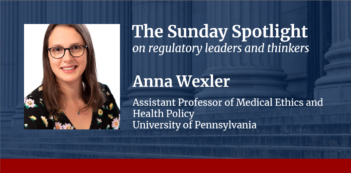
Experts recommend regulatory policies to improve long-term care in the wake of COVID-19.
Nursing homes and other long-term care facilities have been devastated by the COVID-19 pandemic. Nearly one-third of coronavirus deaths in the United States have been residents and employees of these facilities. As of May 2021, confirmed cases in these facilities have reached over one million. The leading explanation for these high rates is that residents’ advanced age and comorbidities make them particularly at risk for severe illness and death from the virus. This risk is compounded by the communal nature of long-term facilities, which increases the likelihood of residents and staff spreading COVID-19. Still, some experts argue that regulatory failures and chronic underfunding are partly to blame for such tragic outcomes in one of America’s most vulnerable populations.
Although the challenges of the COVID-19 pandemic are new, the crisis in long-term care is not. Long-term care facilities have a long history of low-quality care. In 1986, a study by the Institute of Medicine found that nursing home residents were routinely given inadequate care, neglected, or abused. In response, Congress passed the Nursing Home Reform Act, which set new care standards, upgraded staffing requirements, and established an enforcement mechanism for noncompliant facilities. Today, states enforce these standards through unannounced surveys conducted every 9 to 15 months, with variable penalties depending on the severity of the violation.
Most nursing home quality measures have improved over time under this law, but the majority of facilities still fall short of federal standards. In recent years, over 90 percent of nursing homes have received at least one citation per year for violating federal regulations. The pandemic only exposed and amplified these issues. Numerous nursing home residents have reported instances of severe neglect during lockdowns, including extreme weight loss and untreated bedsores.
Neglect for long-term care is also visible in its patchwork funding regime. The majority of long-term care is paid for by Medicaid, which only becomes available once individuals have exhausted their personal assets. Medicaid funding for long-term care also varies dramatically by state and is frequently under threat of budget cuts, especially during economic downturns. For individuals who look to private insurance to cover costs, they often find prohibitively high premiums. Fewer than 1 in 30 Americans own a long-term care insurance plan. Medicare, the primary insurer of Americans over 65 years old, does not cover long-term care beyond 100 days.
As a result of this patchwork system, nursing homes are chronically underfunded. The majority of nursing homes in the U.S. operate at a net loss, and hundreds of nursing homes have been forced to close in recent years. Thin or negative profit margins prompt facilities to cut corners in care quality and staffing levels, perpetuating low quality care. During the pandemic, increased costs have placed nursing homes on the brink of collapse, prompting billions of dollars of federal aid.
Today, approximately 12 million people in the U.S. need long-term care. By 2050, that number is expected to more than double. The challenges of the pandemic present a unique opportunity for policymakers to evaluate how the long-term care system is failing, so as to better prepare for increased demand going forward.
In this week’s Saturday Seminar, scholars explore how regulatory failures contributed to COVID-19 outbreaks in nursing homes and provide potential avenues for reform.
- A viable response to America’s post-COVID-19 nursing home crisis must include increased funding, more regulation, and a new framework supportive of a wide range of long-term care options, Rachel M. Werner, Allison K. Hoffman, and Norma B. Coe of the University of Pennsylvania’s Leonard Davis Institute of Health Economics argue. In a paper published in the New England Journal of Medicine, the authors contend that the coronavirus pandemic has illuminated decades of inadequate long-term care policy. Werner, Hoffman, and Coe call for transformation in funding long-term care and the expansion of alternatives to traditional, congregate-care settings.
- In a paper published in The Georgetown Law Journal Online, Nina A. Kohn of Syracuse University College of Law argues that the effects of COVID-19 on long-term care facilities highlighted long-standing gaps and enforcement failures in federal and state nursing home regulations. To close such regulatory gaps, Kohn recommends strengthening the enforcement of existing regulations, linking Medicaid funding to resident wellbeing, and requiring minimum investments in resident care. Kohn concludes that a stronger regulatory scheme could help end Medicaid’s preference for institutional treatment, rather than community-based treatment, thereby increasing equity for marginalized populations and decreasing structural ageism.
- Tara Sklar of the University of Arizona James E. Rogers College of Law attributes the high proportion of nursing home deaths during COVID-19 to facility mismanagement, including inadequate staffing and poor worker benefits. In a chapter for the COVID-19 Policy Playbook from the Public Health Law Watch, Sklar explains how many direct-care workers were unable to take paid sick leave despite having a right to do so under the federal Families First Coronavirus Response Act, leading to outbreaks in nursing homes. She argues long-term care reform must start with improvements for direct-care workers, including higher wages, better benefits, and stronger staff-to-resident ratios. She offers local, state, and federal recommendations to reduce COVID-19 exposure in long-term care facilities and urges that they be taken immediately.
- In a paper published in The Milbank Quarterly, Walter Dawson of Oregon Health & Science University and his coauthors attribute the COVID-19 crisis in nursing homes to a lack of coordination between the public health system and long-term care facilities. They argue that partnerships between local and state public health departments and long-term care providers occurred too late, leading to early and severe outbreaks in nursing homes. In order to better prepare for the next pandemic, Dawson and his team urge the creation of high-functioning lines of communication between long-term care providers and public health agencies. They also argue that public health agencies should supply resources and supplement staffing in long-term care facilities during public health emergencies.
- In a recent paper, Howard Gleckman and Melissa M. Favreault of the Urban Institute summarize the findings of an expert roundtable on long-term care reform. The roundtable participants generally concurred that Medicaid long-term care should receive more funding and that the current focus on nursing home care should be redirected to Home and Community Based Services. The experts expressed differing views, however, on whether and how switching the Medicaid default could be achieved. Many argued that Medicare was the more appropriate funding vehicle for long-term care, though others felt that the option was politically unrealistic.
- The outbreak of COVID-19 in nursing homes illuminates the market failures and funding gaps for long-term care, Nora Super of the Milken Institute and her coauthors argue. In a working paper with the Wharton Pension Research Council, Super and her team explore the failures of the private long-term care insurance market, which is plagued by low profitability and market shrinkage. Concerned by increasing costs and an aging population, Super and her team suggest expanding Medicare coverage for long-term care. They propose the creation of Medicare Part E (for “Extra”) which would provide a cash benefit to Medicare beneficiaries to use towards long-term care.
The Saturday Seminar is a weekly feature that aims to put into written form the kind of content that would be conveyed in a live seminar involving regulatory experts. Each week, The Regulatory Review publishes a brief overview of a selected regulatory topic and then distills recent research and scholarly writing on that topic.



